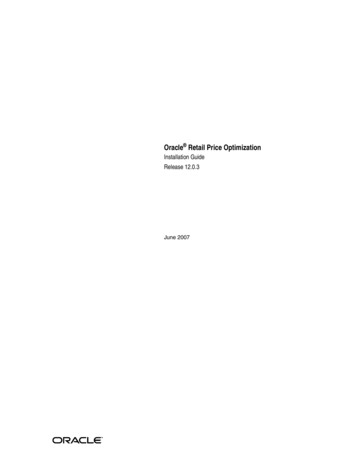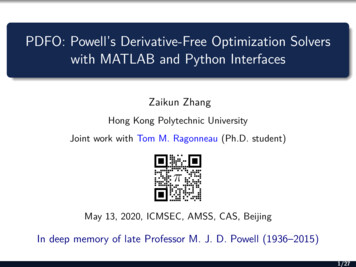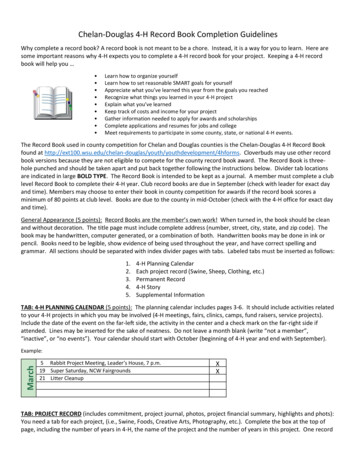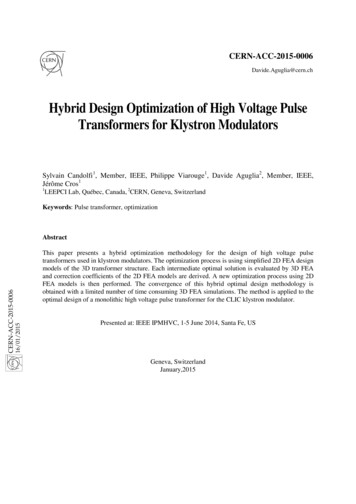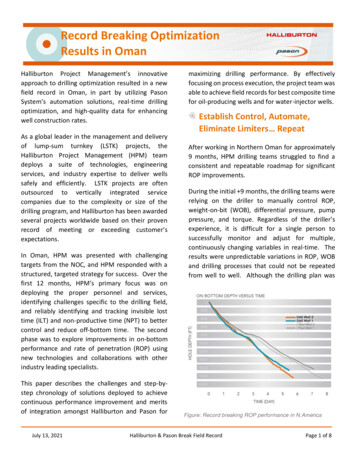
Transcription
Record Breaking OptimizationResults in OmanHalliburton Project Management’s innovativeapproach to drilling optimization resulted in a newfield record in Oman, in part by utilizing PasonSystem’s automation solutions, real-time drillingoptimization, and high-quality data for enhancingwell construction rates.As a global leader in the management and deliveryof lump-sum turnkey (LSTK) projects, theHalliburton Project Management (HPM) teamdeploys a suite of technologies, engineeringservices, and industry expertise to deliver wellssafely and efficiently. LSTK projects are oftenoutsourced to vertically integrated servicecompanies due to the complexity or size of thedrilling program, and Halliburton has been awardedseveral projects worldwide based on their provenrecord of meeting or exceeding customer’sexpectations.In Oman, HPM was presented with challengingtargets from the NOC, and HPM responded with astructured, targeted strategy for success. Over thefirst 12 months, HPM’s primary focus was ondeploying the proper personnel and services,identifying challenges specific to the drilling field,and reliably identifying and tracking invisible losttime (ILT) and non-productive time (NPT) to bettercontrol and reduce off-bottom time. The secondphase was to explore improvements in on-bottomperformance and rate of penetration (ROP) usingnew technologies and collaborations with otherindustry leading specialists.This paper describes the challenges and step-bystep chronology of solutions deployed to achievecontinuous performance improvement and meritsof integration amongst Halliburton and Pason forJuly 13, 2021maximizing drilling performance. By effectivelyfocusing on process execution, the project team wasable to achieve field records for best composite timefor oil-producing wells and for water-injector wells.Establish Control, Automate,Eliminate Limiters RepeatAfter working in Northern Oman for approximately9 months, HPM drilling teams struggled to find aconsistent and repeatable roadmap for significantROP improvements.During the initial 9 months, the drilling teams wererelying on the driller to manually control ROP,weight-on-bit (WOB), differential pressure, pumppressure, and torque. Regardless of the driller’sexperience, it is difficult for a single person tosuccessfully monitor and adjust for multiple,continuously changing variables in real-time. Theresults were unpredictable variations in ROP, WOBand drilling processes that could not be repeatedfrom well to well. Although the drilling plan wasFigure: Record breaking ROP performance in N.AmericaHalliburton & Pason Break Field RecordPage 1 of 8
sound, the team was unable to achieve significantimprovements in ROP due to the extreme variationand lack of control.DAS Target Based – Pason Drilling AutomationSystem (DAS) is an automatic drilling systemdesigned for use on both Brakehandle and AC rigsTo help solve this problem, the Halliburton ProjectManagement team tasked Pason Systems to firstaugment the rig’s existing Electronic DrillingRecorder (EDR) and sensor set installation toimprove data quality and real-time visibility, andsecond to integrate the Pason ADR and DAStechnologies into the rig’s existing PLC system.with programmable logic controllers (PLCs). DASThe initial objectives of the trial were to:Mitigation technologies, Pason Drilling Automation Target Based controls the drawworks to maximizerate of penetration (ROP) by automatically adjustingthe control limits (ROP control, WOB control, torquelimiting, target differential pressure) based on thewell plan.Pason DAS Boundary Based – Based on MechanicalSpecific Energy (MSE) Optimization and Stick-SlipSystem (DAS) Boundary Based utilizes patentedOptimize the 12 ¼” section of the well that isdrilled with TCI and motor (resulted in 6.9% onbottom ROP improvement)Optimize the 6 ⅛” section of the well initiallydrilled with Geo-Pilot Rotary Steerable Systemsand iCruise Intelligent Rotary Steerable Systemand PDC bit (resulted in 17.9% on-bottom ROPimprovement). With customer approval onselect wells, significant savings can be achievedby transitioning to a mud motor through thissectionAchieve further benefits by utilizing Pason’sData Delivery and Analytics Services throughoutthe well planning and well execution phases,with a focus on real-time data, drilling keyperformance indicators, and enhanced rigactivity tracking through advanced IADC toursheet time codesalgorithms to identify and implement optimumdrilling parameters in real-time while working withinspecified technical limits or boundaries unique to therig, formation, or BHA.*DAS is a trademark of and contains technologylicensed from ExxonMobil Upstream ResearchCompanyThe pilot program was organized in 3 phases. Phase 1: Installation of the Pason system to gainfurther insights on the drilling performancethrough improved data quality and access toreal-time data in 1-sec resolutionPhase 2: Installation of the DAS Target Based(AutoDriller) to improve control of drillingoperations and better identify ROP limitersFigure: WOB control scheme – Process Flow from Driller to Drill BitJuly 13, 2021Halliburton & Pason Break Field RecordPage 2 of 8
Phase 3: Integration of DAS Boundary Basedtechnologies into both the planning phase anddrilling phaseTraining on Pason system was completed both in theoffice and the rig site, and the goal of the projectwas communicated to the entire team. Drillingengineers, RTOC engineers, driller, rig manager,company man (DSV), and directional company allreceived a common message: set the drillingparameters and let Pason DAS control block speedand WOB.Six trial runs using the Pason AutoDriller (DAS TargetBased Drilling) were deployed for each of the 2selected rigs. During each run, the Pason EDR wasable to record the active DAS control limit (ROPcontrol, WOB control, torque limit, or targetdifferential pressure).During drilling operations, this informationencouraged conversations around modifications tothe existing well plan. During post-well analysis itallowed the Halliburton optimization team to clearlyidentify the limiter of each well section for changesin future well planning.Using the data collected, aggregated, and stored byPason, Halliburton was able to identify several ROPlimiters: Surface torqueGeological uncertaintyHigh density formationsDrilling bit limitsDifferential pressureOnce the team understood and was able to quantifythe ROP limiters, the Halliburton optimization teamwas able to create their plans for drilling parameteroptimization for the upcoming wells.heavily on good data. This meant a requirement forand reliance on high quality and high-resolutiondata.High Quality / High ResolutionData Halliburton Project Management team’sanalytics tools require high quality data to yieldconsistent and repeatable drilling plansData accuracy and reliability are keyHigh resolution (1-second) real-time data allowsreal-time monitoring and real-time analysis ofdrilling performance, allowing for the revision ofcurrent drilling plans as neededSensor data that is fit for purpose eliminates theneed for data cleaning real-timeFocus on “Good Data”Similar to other technology companies, bothHalliburton and Pason have invested millions ofdollars and countless man-hours developingindustry leading Artificial Intelligence (AI) andMachine Learning software solutions focused ondrilling safer and more efficiently. While many ofthese solutions deploy leading edge technology, thereality is they rely on accurate, high quality, reliabledata to produce an output that is valuable andmeaningful.Recognizing this need, Pason’s R&D departmentspent several years redesigning the way in whichPason’s systems receive, store, and manage data,including several initiatives focused on predictiveand preventive maintenance of Pason’s equipmentthrough remote diagnostics and 24 hour monitoringof component level and overall system health. TheTo successfully achieve high levels of ROPoptimization using automation, Halliburton focusedJuly 13, 2021Halliburton & Pason Break Field RecordPage 3 of 8
DataPreparationFigure: SOURCE: CrowdFlower 2016results have been an overwhelming success towardsPason’s goal of creating a standardized, scalable,and secure data delivery system from raw sensordata to analytics and AI solutions.“We noticed that in previous projects with other 3rdparty sensors, data quality was sub-optimal. Wewere looking for a data provider that did not sufferfrom gaps or issues with data quality,” stated KhaledAbdelaal. “We solved this problem with the Pasonsystem.”Importance of VariationReduction and Proper ControlParameters Variation reduction is critical for the followingreasons:o To more easily and accurately identifyperformance limiters; drilling systemcontrol state is needed to properly identifyHalliburton’s optimization teamperformed minimal data cleaning toensure accurate on-bottom ROPand ROP limiters. The data wasanalyzed on over 40 wells stored inPason’s DataHub and found lessthan 2% data accuracy issues whichwere negated by running certaindata cleaning algorithms. Forreference, other data recordingsystems have demonstrated up to30% errors in data accuracy and / orreliability.Figure: AutoDriller ImpactJuly 13, 2021Halliburton & Pason Break Field RecordPage 4 of 8
and quantify performance limiters in eachsectiono To reliably deploy improved drillingstrategieso To accurately attribute improvements to aspecific change in the well planThis continuous improvement cycle of “Identify– Plan – Execute – Review” can then be used tocreate an optimization roadmap for subsequentwellsAs more wells were drilled utilizing the Pasonsystem, additional efficiency improvements andcost savings opportunities were discovered. Improvements In On-Bottom ROPand BeyondIt is common for customers to focus solely on ROPimprovements as their measure of Return onInvestment (ROI). ROP is easy to quantify and quickto compare from well to well. However, there areseveral other areas where cost savings andsignificant drilling improvements can be achieved;they are simply more difficult to measure and forthis reason are often ignored. Maximum average ROP times and remarkablereduction in the drill-out timesIdentify sections where further increasing ROP isnot possible with current system restraints. Thisdetailed understanding of the main ROP limitersper hole section provides the basis fordeveloping mitigation plans to remove thoselimiters.o Bit selection, BHA configurations, mudweights, torque limits, target differentialpressure, and other factors can be revisedto further optimize drilling operations.Reduced vibrations results in less wear and tearon the rig and downhole equipment:o Decreased stress on the drill string, motor,and bito More consistent Depth of Cut (DOC) or bitengagement, which can significantly reducebit wear and hole qualityo Minimized opportunities for motor stallsToolface easily held by directional handso The smoother the WOB, the smoother thedelta p, which in turn helps motor efficiencyand helps hold toolfaceMinimal bit wear by reducing drillingdysfunctionsPotential for longer runs10.7% Faster7.2% Faster17.9% Faster6.9% Faster16”12 ¼ ”8½”6 1/8 ”Figure: Average on-bottom ROP performanceJuly 13, 2021Halliburton & Pason Break Field RecordPage 5 of 8
Improved connection timesachieved by eliminatingovertorque in the drill string jointsservice companies and take into consideration anyexisting Contractor/Operator’s best practices.One specific area to be highlighted is theimprovement in connection times following thedeployment of the Pason system, as this significantcost savings was not expected.When drilling manually, drillers often stay wellwithin rig equipment limitations. This can reducedrilling optimization opportunities. For optimaldrilling performance, the drill string and rigequipment limitations should be documented asoperating boundaries, allowing the driller to searchfor optimum performance without the risk ofdamaging equipment. Setting the correctboundaries may require buy-in from multiplevendors (bit vendor, directional company, etc.).Once the parties were trained and the correctboundaries were established, the DAS BoundaryBased AutoDriller system could be fully utilized toensure the optimization space was maximized.Before the first well was completed, the companyman was already commenting that the tripping outperformance had improved. Post-well analysis ofthe data proved what the rig crew had observed:removing the driller and replacing him with the DASsystem resulted in 10% to 20% faster breakoutconnections. The consistent, controlled applicationof WOB reduced the occurrence of overtorquealong the drillstring. This alone saved 108 minutes.* NOTE - Similar results were achieved on anotherPason trial in Oman, where the Customer recognizeda total reduction of over 1,000 minutes in connectiontimes alone.Led by the HPM team, Halliburton and Pasonworked together in Oman to achieve a significantcontribution to ROI using automation, high-qualitydata, and a proven planning process to create ablueprint for success.Failing to Plan is Planning to FailPason has worked with several partners over theyears and recognizes that changing customerworkflows can be challenging. Empowering skilledcrews through a well-planned training program canhave a dramatic impact on the success ofautomation efforts at a rig site. A robust trial plan iskey. The project management team should includeall people in the drilling operation, must have achampion, and must define measurable results. Itshould include the drilling contractor and otherJuly 13, 2021Conservative operating parametersAn Accurate Roadmap Leads to an Efficient JourneyThe planning phase should challenge existinglimiters and highlight potential areas open forcontinuous improvement. Upon review, the Omanoptimization team identified the following areas forimprovement: Overly conservative operating parametersInability to consistently follow roadmap limitsWhen following roadmap limits, it is important toutilize a wide limit window, make infrequentsystem changes and allow the system to optimize.On-Bottom Drilling PerformanceThe average on-bottom ROP improvement was10.5 %. On-bottom ROPs shown above are based onaverage ROP delivered by both Rig 1 and Rig 2from 5 wells drilled before and after systemdeploymentHalliburton & Pason Break Field RecordPage 6 of 8
On-bottom ROPs improvement delivered by theAutoDriller system in Rig 1 is 9.2% and 11.9% inRig 2Off-Bottom Drilling Performance 31% reduction in shoetrack drill-out time27% reduction of DC/HWDP overtorque issues inthe 16” holeTotal Time Improvement 4% improvement in total well time12% improvement in well construction rateWhat Gets Measured GetsManagedDuring the trials, consistent and repeatable successwas achieved. The Pason multi-parameterAutoDriller operated off Halliburton’s roadmap thatincluded targets and limits for ROP, WOB,differential pressure, and torque. The AutoDrillerautomatically adjusted the active control stateaccording to the roadmap targets and limits. Realtime optimization through automation helped tofurther quantify and visualize the limiters. Thelimiters could then be safely pushed higher. Thesenew limits were used to remodel the drilling planthat would ultimately achieve success in ROPoptimization. Successful deployment of theAutoDriller system assisted in improving the onbottom ROP of Rig 1 by an average of 9.2% and ofRig 2 by an average of 11.9%.Halliburton achieved significant ROP optimizationby integrating Pason’s unique automationtechnology with their innovative drillingoptimization process. They will continue to createvalue for their customers using this record-breakingapproach.8.8% Faster16.0% Faster3.3% Faster16”12 ¼ ”8.9% Faster8½”6 1/8 ”Figure: Rig 1 ROP performance; improvement of 5.9 hrs (average)July 13, 2021Halliburton & Pason Break Field RecordPage 7 of 8
12.9% Faster26.3% Faster11.1% Faster16”12 ¼ ”8½”6 1/8 ”Figure: Rig 2 ROP performance; improvement of 13.0 hrs (average)Halliburton Optimization Team: This team is led byKhaled Abdelaal. He has been in the drilling industryfor 18 years with a proven track record in optimizingwell designs, implementing new technology andimproving operational procedures. He has workedin Austria, Egypt, and now in Oman as Principal WellEngineer for Halliburton Project Management. Heholds BSc degree in Petroleum Engineering.Khaled was successfully able to develop integratedmodels utilizing data analytics for drillingoptimization as well recognizing trends in real-timedata which relate to improvement opportunitiesand avoidance of drilling hazards through Pason’shigh resolution real-time data. He believesintegration of machine learning, prescriptiveanalytics and lean ways of working can save cost,time and most importantly make industrialworkplaces safer.Pason Systems Inc: Pason is a leading energyservices and technology company. We develop anddeliver high-value hardware, software, and services,primarily for the oil and gas drilling industry in 12countries. Our motto is: Technology DeployedSimply. Our mission is to improve the effectiveness,efficiency, and safety of drilling operations.Contact Pason for detailed information on how tomaximize your drilling ROI.https://pason.com/contact-us/Contact Halliburton to learn more about how theycan create and deliver your optimization tionJuly 13, 2021Halliburton & Pason Break Field RecordPage 8 of 8
specific change in the well plan This continuous improvement cycle of "Identify - Plan - Execute - Review" can then be used to create an optimization roadmap for subsequent wells As more wells were drilled utilizing the Pason system, additional efficiency improvements and cost savings opportunities were discovered.
